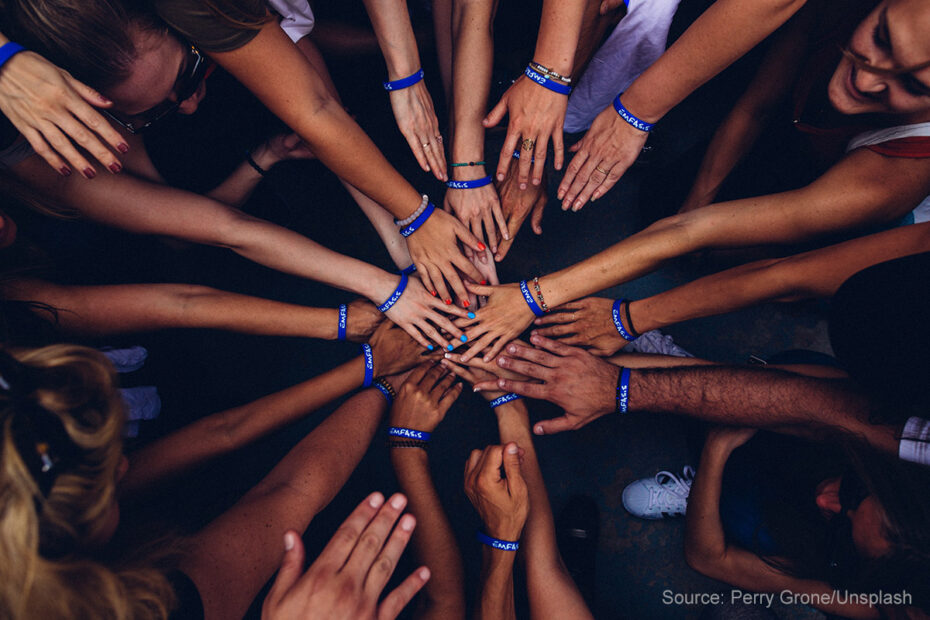Stronger together: How being a light to others cultivates health & joy for all.
Stronger together than apart is a phenomenon called collective efficacy. Look no further than the extraordinary altruism in support of our country’s health care workers to see how selfless acts of service bring a community together in tangible and palpable ways. This group dynamic, one with widespread effects throughout the brain and body, creates a feeling of unity and convergence within a community, connecting every individual biopsychosocially with an energy force larger than themselves.
This collective and fundamentally human feeling of connection is the core feature of “Blue Zone” communities—the healthiest and longest-living populations on our planet.
Our brains may be evolutionarily hard-wired for altruism via the powerful, positive feedback loop that feeling like part of an entity larger than oneself sets into motion. Selfless acts are associated with a specific pattern of brain activity within the limbic system (emotional processing), key cortical areas within the “mentalizing network” (reputation and self-referential processing), regions such as the nucleus accumbens and anterior cingulate cortex (reward-processing areas related to pleasure), as well as structures in the salience network, such as the amygdala (which alerts us when to feel fear and how to react), that guide our attention toward what to focus on and away from what is deemed helpful to ignore.
In this biosocial story, the emotions we feel when helping others were designed to feel good, partly to ensure the survival of our species but also to actively promote the safety and well-being of those we love.
Whatever the motivation, selfless behavior is contagious within groups, as shown by research demonstrating higher levels of cooperativeness when surrounded by those of like-minded orientation. Moreover, altruism can have a 3-1 multiplier effect (contagious up to 3 degrees of separation), fueling an upward spiral of biochemicals, such as oxytocin (the “love” hormone, important for human connection), serotonin (induces positive mood states, higher levels combat depression), dopamine (linked to novelty, excitement, and adventure), and epinephrine (provides fast and immediate energy).
Service to others, helping those around us, is a core element in human flourishing, as it is characterized by the systemwide neurobiological response that fortifies broad measures of health, wellness, and quality of life.
And here’s the bonus: While “paying it forward” can improve the condition of the one who receives, studies reveal that altruism can be even more powerful for the physical health and psychological well-being of the one who gives.
It takes only one person—in a single moment—to spark the neurobiological change that temporarily transports us away from a narrow state of psychological burden, creating space to “upshift” into a broader mindset of possibility and hope.
Compassionate Acts of Service
The biochemical “upward spiral” is triggered when we intentionally and voluntarily choose to engage in planned or random acts of kindness.
- Say thank you! Express gratitude for those who are leaving exhaustion and fear behind in service to others. This can include teachers, health care workers, grocery store clerks, delivery people, bus drivers, and those in your own family.
- Help celebrate milestones! Write a note and mail or hand-deliver it, especially to those who are single or elderly in your life or neighborhood.
- Create a “Day of Kindness” once per week with your family or friends. Choose 3-5 things that are easy to do: Call a relative, draw a picture for a get-well card, do a household chore without being asked, or learn a recipe from a grandparent via Zoom.
- Smile with your eyes and say a warm-hearted “Hello!” while out and about. Give others a sense of the human being behind the mask. As we know from science, smiling with our eyes lights up an entirely distinct, joyful neurobiological pathway.
- Run an errand for a neighbor, or cook a meal for a friend.
- Check-in with friends who are struggling and affirm that you are there for them, and be there to celebrate their happy moments too.Remember the concept of “mudita”—feeling pure, sympathetic joy with others, unadulterated by self-interest.
When we look back on this chapter in history, what will we remember about the choices we made in order to survive, thrive, and lift others in our midst? What are the stories we will tell our children and grandchildren about the power of the human spirit, adaptation through adversity, and the moments that helped us see the ray of light on the horizon?
Here is the story. We weathered the storm and emerged stronger, healthier, more resilient, and more closely connected than we were before. We achieved post-traumatic growth by standing together, hand in hand.
As Bryan Stephenson, civil rights advocate and founder of the Equal Justice Initiative, says: If you want to make our world a better place, “get proximate.” Live your message by helping others in ways that are personal, feasible, and comfortable for you. By making service a part of your narrative, modeling it in your home, virtual workplace, and community, you are a light to others who follow your lead.
“We must be the change we wish to see in the world.” —Mahatma Gandhi
A version of this article was first published by Turnaround for Children on the 180 Blog.
